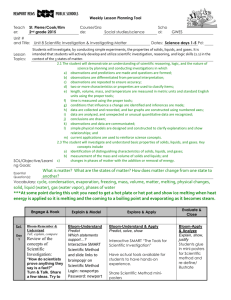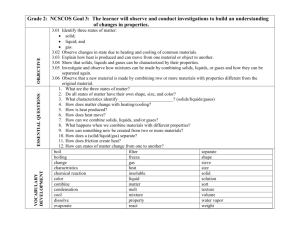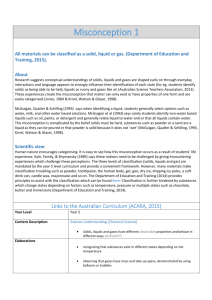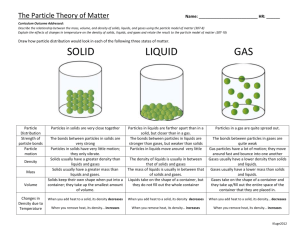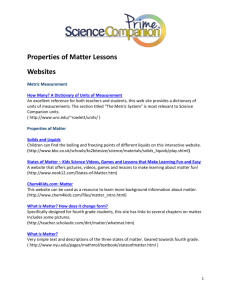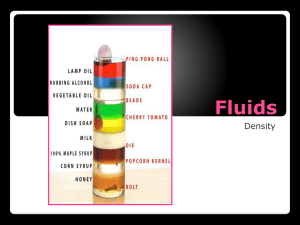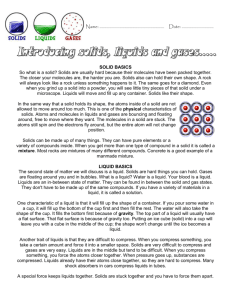solid, liquid
advertisement
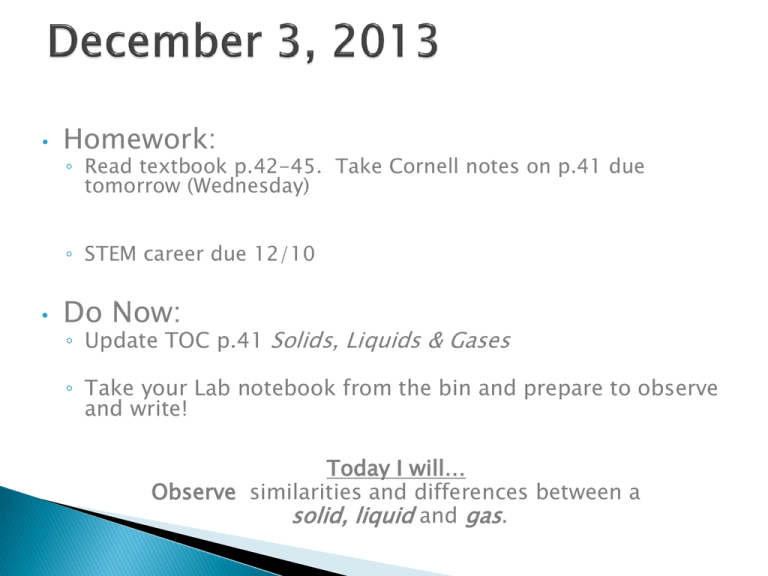
• Homework: ◦ Read textbook p.42-45. Take Cornell notes on p.41 due tomorrow (Wednesday) ◦ STEM career due 12/10 • Do Now: ◦ Update TOC p.41 Solids, Liquids & Gases ◦ Take your Lab notebook from the bin and prepare to observe and write! Today I will… Observe similarities and differences between a solid, liquid and gas. Which is easiest to hold in your hands– a small rock, 100ml of water, or the helium from a balloon? -Write your answer in your journal Carefully observe the demonstration. Write your observations in your journal and identify examples of a: ◦ Solid ◦ Liquid ◦ Gas What changes do you see? Are they physical or chemical and why? Each student represents a molecule! Form a circle around the room with your arms extended straight in front of you with your hands on the person’s shoulders in front of you. When the music stops, FREEZE and listen for directions! http://app.discoveryeducation.com/search#s elItemsPerPage=20&intCurrentPage=0&No=0 &N=18342&Ne=18339&Ntt=gas&Ns=&Nr=& browseFilter=&indexVersion=&Ntk=All&Ntx= mode%252Bmatchallpartial http://www.youtube.com/watch?v=3q As1Nt0Fjk http://www.youtube.com/watch?v=UJX Drh9ESCI Bill Nye- Phases http://www.middleschoolchemistry.co m/multimedia/chapter1/lesson5#com paring_solids_liquids_and_gases Do Now: ◦ Take out p.41 Solids, Liquids & Gases (Cornell Notes) ◦ Update Agenda: Write down homework ◦ Update TOC (In Science Notebook) p. 42 Solids/Liquid Lab • Homework: ◦ Read pages 46-47 complete Cornell notes in notebook due tomorrow ◦ Finish Venn Diagram (Compare and Contrast Solids and Liquids ◦ STEM career due 12/10 Today I Will… Describe the characteristics and types of solids, liquids, and gases Choose only 1 candidate (state of matter) and tell me why you voted for that candidate. What was it about the state of matter that impressed you the most? □ Solid □ Liquid □ Gas Are defined by whether it has: ◦ A definite Volume ◦ A definite Shape In your Notebook: ◦ Write your definition of a solid (in your own words). A Solid is…. ◦ Provide 3 examples of a solid. 1 2 Go back to the 3 examples of solids that you listed in the beginning of class. What category do they belong to? ◦ Crystalline (C) or Amorphous (A) Observe the three containers of green liquid: ◦ Mini bottle , small food container, and graduated cylinder Record observations: Compare and contrast List two ways the green liquids in the containers are a like Two ways they are different Video: Heat glass http://www.youtube.com/watch?v=HA Pc6JH85pM Homework: ◦ Bring textbook to class tomorrow ◦ Mini Quiz on Wednesday 12/11(States and Changes of Matter) Review your notes ◦ Complete Cornell Notes summary for all notes from pages 42-47 on p. 43 due tomorrow Do Now: ◦ Update TOC Solids : p. 44 Venn Diagram Liquids vs. p. 45 What is Viscosity? Today I will… Observe different characteristics of liquids and gases Using the Venn diagram handout, write 2 similarities (compare) and 2 differences (contrast)about the Solids and Liquids In your Small groups: Carefully observe the two different liquids. What do you see? Write your results on p.45 (Draw diagrams if you’d like) Then Return the jars back over, What do you see ? Write your results on page 45. Go back to your seat and Answer these question in your notes after observations: 1) Which Fluid has a greater viscosity? 2) What evidence leads you to this conclusion? - You Can draw a diagram if you want to help explain your answer • Do Now: • Homework: 1) Take out Homework : Cornell Notes Summaries (If you wrote two small ones or Summary (If you wrote one large one) 2) Write HW in agenda! 3) Update TOC- p46 Bill NYE Video Facts –Phase Change ◦ Bring textbook to class Monday ◦ Mini Quiz on Wednesday 12/11 (States and Changes of Matter) ◦ Finish the two Challenge Questions from the Bill NYE Video Today I will… Learn about different Changes of State. http://www.youtube.com/watch?v=69TLWiYY 1QI Surface tension What is something you heard in the video that helped you better understand surface tension? A gas DOES NOT have a definite shape or volume. As gas particles move, they spread apart, filling in the space available. How does breathing demonstrate that gases move freely? Write Answer on page 45 http://www.youtube.com/watch?v=UJXDrh9E SCI Bill Nye- Phases On p. 46- Glue in Worksheet, Follow along with the video and answer fill in the blank questions


